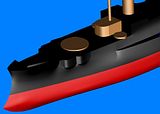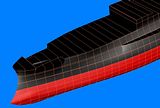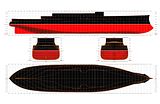Robert, here's a few ideas for you.
1) if you're designing your own hull, I would highly recommend that you try out the free CAD program DELFTship. It's a surface modeler specifically intended for ship design. I use it to make computer models of historical ships, when my paper plans don't provide enough detail for an accurate hull. This program can also calculate statistics like displacement, water resistance formulas, etc. Very nifty stuff. My most recent project was the Russian predreadnought battleship Borodino:





They also have a number of free hull designs online, including a number of cargo ships, super-tankers, and other tubby hulls. You would just need to re-scale the hull you want to the correct size, pick which ribs and cross-sections you want, and tell it to generate a set of plans. Very useful.
2) have you considered buying a fiberglass hull pre-built? There are a number of R/C combat suppliers, who make warship hulls out of fiberglass. You can buy a large 1:144 scale battleship hull, and convert it into a carrier. Your best bet for this would probably be the Strike Models USS Iowa hull:
http://www.strikemodels.com/products/ships/uss-iowa/
The best part of this is that, by buying a hull ready-made, you don't have to worry about designing a hull, building a mold, making your own fiberglass hull, getting a thick enough layer of fiberglass, etc. Just open the box and start installing components. The Iowa hull in particular is big, stable, and sleek. And if you install the skegs, you'll have extra protection against rocks and other underwater obstacles.
Whichever solution you choose, Grael is right: you'll need to waterproof everything in your planes and helicopters, and make sure they float. You wouldn't want to wreck an expensive helicopter or airplane just because you missed the flight deck by a foot. There are a number of waterproof servos available, from Traxxas and other companies, or you can seal them yourself. The method Grael described is one way, suitable for shallow-water immersion. Other R/C combat skippers on this forum know of additional methods for a wider range of conditions, that we can describe if you want.